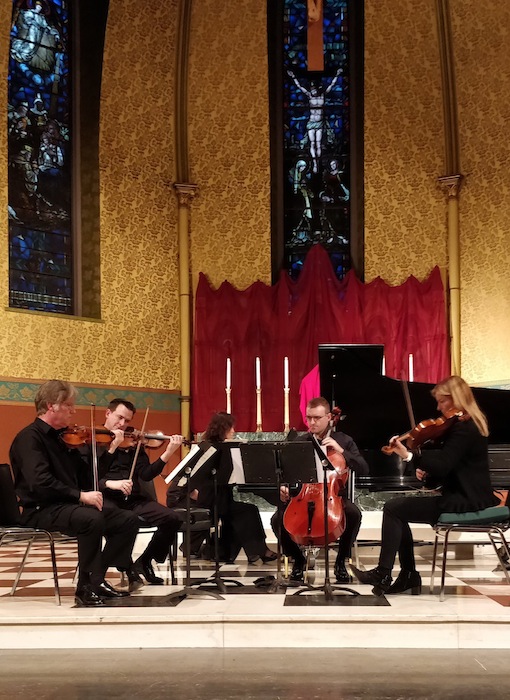Rembrandt Chamber Musicians unearth a gem in Eastern European program

Bohuslav Martinů remains the most inexplicably neglected composer of the 20th century. The prolific Czech (1890-1959) wrote with astounding versatility in every genre: six symphonies, nine concertos, and reams of chamber music, including sixteen quartets (seven of them string quartets) and three piano quintets. Martinů’s music is of a consistent high quality, his style an attractive middle ground between Neoclassicism and a lean Romanticism–lyrical yet with an astringent edge.
Two Martinů works were heard Friday night at St. James Cathedral where the Rembrandt Chamber Musicians presented a venturesome concert of Eastern European rarities. No doubt the lack of familiar composer names on the program contributed to the rather sparse turnout.
The evening began with Martinů’s Promenades. This work dates from 1939, shortly before the Nazi subjugation of Czechoslovakia from which the composer would flee to the U.S. Yet there are few shadows in this lighthearted trio for flute (Sandra Morgan), violin (David Perry) and harpsichord (Andrew Rosenbloom). Rhythms could have been more incisive at times and the harpsichord sounded rather muted in the resonant acoustic. But the three musicians were fully in synch with the score’s Neoclassical esprit, from the breezy opening movement to the nostalgic Adagio and ebullient, silent-movie-chase finale.
Also heard was Martinů’s Quartet of 1947, scored for the offbeat forces of oboe (Robert Morgan), violin (Robert Macfarlane), cello (David Cunliffe) and piano (Jeannie Yu). The quartet is similarly Neoclassical in style, though with a more restless edge, traces of dissonance surfacing in the gear-shifting rhythms. Pianist Yu brought drama to the Adagio’s opening piano statement as well as lyric charm elsewhere. But the latter quality was only intermittently in supply, in a sturdy performance that would have benefited from more refining of details and balances.
The same reservations applied to Ilja Hurnik’s Variations on a Theme of Pergolesi. The late Czech composer and polymath (1922-2013) wrote this sextet arrangement for the Rembrandt ensemble in 1995, repurposed from his original for four-hand piano of a decade earlier.
Hurnik mines an impressive array of permutations from Pergolesi’s stately theme. Yet in this retooling the composer never really exploits the expanded instrumentation in an interesting way. Scoring is unduly heavy and the lines are often doubled, tripled and quadrupled with insufficient showcase opportunities for the individual musicians (flutist Morgan, oboist Morgan, violinist Macfarlane, violist Carol Cook, cellist Cunliffe and pianist Rosenbloom).
Perhaps a better-blended ensemble and more attentive balancing would have made a better case for this retooling and contrasted the ten variations more piquantly. There was little delicacy in the Delicato section, for one example, and an unvaried loudness prevailed, the generalized garrulity exacerbated by the washy acoustic.
The evening concluded with Erno Dohnányi’s Piano Quintet No. 1. Written as a student in Budapest, this is a stunning achievement for any 18-year-old who isn’t Mozart or Mendelssohn. Dohnányi’s 1895 quintet is chockablock with rhapsodic melodies, skillfully distributed among the musicians and handled with striking panache. One can understand why Brahms was so impressed by this work that he arranged for a Vienna performance, which immediately launched Dohnányi’s career.
Dohnányi’s quintet received the finest and most polished performance of the evening. From the impassioned opening theme, grandly presented by pianist Yu and then moving to the strings, the playing in the first movement had a real sense of sweep and cohesion. Following a skittering Scherzo, the Adagio begin with a lush, expansive theme, rendered by violist Cook with burnished, mahogany tone. With quite beautiful playing by all, the musicians captured the yearning romanticism of this score, not least David Perry’s sweet-toned violin. The finale is imbued with a folk-like feel and worked up a considerable head of steam en route to a bravura coda.
It’s hard to fathom why Dohnányi’s terrific quintet isn’t performed more regularly. Kudos to the Rembrandt ensemble for this timely exhumation and for bringing the Hungarian composer’s work to life with such strong engagement and commitment.
The program will be repeated 3 p.m. Sunday at Nichols Concert Hall in Evanston. rembrandtchambermusicians.org
Posted in Performances

